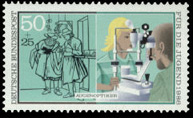
 Direct ophthalmoscope is portable and
easy to use. However, studies showed that it has low sensitivity, though
high specificity in diabetic retinopathy screening. The main reason being
the limited field of view of the retina.
Direct ophthalmoscope is portable and
easy to use. However, studies showed that it has low sensitivity, though
high specificity in diabetic retinopathy screening. The main reason being
the limited field of view of the retina.
 Slit-lamp is routinely used by ophthalmologists
in the detection of diabetic retinopathy. It allows a wider view and therefore
more sensitive. It is the 'Gold standard' method for ophthalmoscopic detection
of diabetic retinopathy.
Slit-lamp is routinely used by ophthalmologists
in the detection of diabetic retinopathy. It allows a wider view and therefore
more sensitive. It is the 'Gold standard' method for ophthalmoscopic detection
of diabetic retinopathy.
The Diabetic Retinopathy Study Group26 and the British and Study
Group 27 have shown that photocoagulation is effective in the treatment
of proliferative retinopathy. Treatment is particularly effective when
given early and adequately and joint initiatives for screening for diabetic
retinopathy as shown by the Brunel study1.
.
Similarly the British and Study28 and the Early Treatment of Diabetic
Retinopathy Study14 have shown that visual loss due to diabetic
maculopathy can be reduced, especially when the lesion are early, and
the vision still good.
.
As the earliest forms of retinopathy, when treatment is also most
effective, are not associated with visual symptoms, it is essential that
these should be detected. DR therefore represents an excellent paradigm
for screening as laid out in the principles for screening of human disease29.
Screening for diabetic retinopathy is cost effective in health economic
terms30-32.
.
Comprehensive screening programmes for DR in the UK are difficult
to put in place since there is as yet no complete register of all diabetics
in all health regions. however, attempts should be made to achieve full
coverage of the patient population through the establishment of district
wide diabetes registers.
.
Screening may be undertaken for two reasons: the detection of disease
of any severity and the detection of disease of sufficient severity to
require consideration for treatment. The latter constitutes the
"indications for referral to the ophthalmologist" and is dealt with below.
.
Screening modalities include fundoscopy, which can be performed by
various individuals with different levels of expertise, and photography
with a fundus camera with or without mydriasis.
.
Several studies on the value of screening11,30,32-39 have led to the
following general recommendations proposed in a parallel guidelines
document in preparation by the European Consensus Document and the
conference of Scottish Royal Colleges:
.
- all patients aged over 12 years and/or entering puberty
- screening should be performed annually and should
- screening should be performed in the most appropriate
should be screened
.
include a measurement of visual acuity and examination
of the fundus through a dilated pupil
.
and comprehensive manner and will involve a combination of:
.
a. diabetologists for patients attending hospital diabetic
clinics
.
b. optometrists, usually in densely populated urban areas,
as primary screeners for diabetic patients being treated
by their general practitioner, if the GP does not wish to
perform the screening him/herself
.
c. photographic screening for patients for whom neither of
the above is available eg. in rural communities. Photographs
would be evaluated by primary screeners at diabetic clinics
or GP practices.
.
Combined modality screening may be useful in certain circumstances.
In this case the opinion of a trained ophthalmoscopist, whether
physician, ophthalmologist or optometrist, is combined with photography
through a dilated pupil, the photographs being evaluated by a trained
observer. While labour intensive, the number of missed is greatly reduced.
Whichever screening method is employed in any region, it is important
that the results of screening and indeed treatment outcomes from the
screening programme, are audited and validated.
.
With rapid advancement of technology, new methods for screening are
now available including digital photographic and computerized methods for
detection and assessment of retinopathy. While opinions remain divided
as to the best screening modalities, it should dbe possible to develop an
effective screening programme based on a single modality, thereby
reducing duplication, cost and sources of error. A number of research
programmes are currently in progress to evaluate the various modalities.
All new screening methods however, should be tested for sensitivity and
specificity against known standards. In addition, the screening procedure
in each centre should be audited regularly by independent assessors to
ensure uniform standards of care.
.
4.2 Indications for referral to an ophthalmologist
The main purpose of screening is to detect patients who require treatment
and to refer them to the ophthalmologist in good time, when vision can be
saved, or possibly improved.
.
Urgent referral is indicated in the following conditions:
- new vessels on the disc
- new vessels elsewhere
- preretinal and/or vitreous haemorrhage
- rubeosis iridis
- retinal detachment
.
These patients should be seen on the same day in the case of retinal
detachment and vitreous haemorrhage and within 2-3 days in the
case of new vessels.
.
Early referral is indicated in the following conditions:
- "high risk", pre-proliferative retinopathy
- non-proliferative retinopathy with macular involvement
- haemorrhages and/or hard exudates within one disc diameter from
- reduced visual acuity not corrected pinhole, suggestive of macular oedema.
the centre of the fovea
These patients should be seen within 3-4 weeks.
.Routine referral for an ophthalmological opinion should be made for
the following conditions:
- non-proliferative retinopathy with large circinate or plaque exude
- retinal findings that are not characteristic of diabetic retinopathy
- background retinopathy with reduced vision but without maculopathy
within the major temporal arcade but not threatening the macula
to determine cause of visual loss.
.